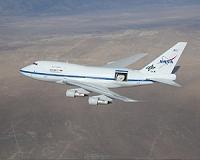 |
Iowa City IO (SPX) Jan 14, 2010 Two University of Iowa researchers have made the first direct radio image of a stellar coronal loop at a star, other than the sun, thereby providing scientists with information that may lead to a better understanding of how such phenomena as space weather affect the Earth. Robert Mutel, professor in the University of Iowa College of Liberal Arts and Sciences Department of Physics and Astronomy, and his graduate student William Peterson of Marshalltown, Iowa, spearheaded the research, which included astronomers from New Mexico and Switzerland. They published their findings in the Jan. 14 issue of the Journal Nature. Mutel said that the image of the coronal loop (roughly resembling a rainbow) was made of the star Algol, a well-known variable star in the constellation Perseus. Algol (Arabic for demon) is also know as the Demon Star and is one of the first eclipsing binary stars and variable stars to have been discovered. Its brightness as seen from Earth temporarily decreases roughly every 69 hours. "We imaged the coronal loop using a global array of radio telescopes," Mutel said. "We also carefully compared radio and optical coordinates, so we know where the radio source was located with respect to the star." "Earlier attempts to image stellar coronal loops in visible light resulted in fuzzy blobs, but we used a global array of radio telescopes to make a series of images over a six-month period. High resolution radio interferometery allows us to image features which would otherwise be undetectable." The instrument Mutel and Peterson used is actually a combination of 13 radio telescopes linked by computer. They include the 10-telescope VLBA (Very Long Baseline Array) composed of telescopes in Mauna Kea, Hawaii, St. Croix in the Virgin Islands, and North Liberty, Iowa; a 100-meter instrument at the Max Planck Institute for Radio Astronomy near Bonn, Germany; the National Radio Astronomy Observatory (NRAO) at Green Bank, W. Va.; and the NRAO's Very Large Array (VLA) in New Mexico. Despite the impressive coordination of telescopes dedicated to capturing information from Algol, making sense out of all the data is difficult. "Learning how to take radio data and turn it into an image is a challenge," Peterson said. Interpreting the data is perhaps just as challenging. Mutel noted that the coronal loop at Algol is similar to those at the sun, but the magnetic field at Algol is about 1,000 times more powerful. Peterson said that the larger-than-predicted size of the coronal loop is probably due to the tidal effects of the companion star distorting the loop and stretching it. Additionally, the companion star causes the coronal loop to continually face the companion star. Mutel said that a better understanding of Algol's coronal loops might help us to better understand the sun, something that could benefit a wide range of human activities. "We really need to understand our sun," he said. "The sun is close to us and can be studied, but it is only one star. By studying other stars, we will be able to put its behavior into a broader context. "Coronal loops at the sun are associated with sunspots. Sunspots, in turn, are associated with space weather, a constant stream of charged particles flowing outward from the sun. The intensity of solar radiation can affect everything from communications systems that rely on satellites to the health of astronauts who must sometimes work in space." Mutel said that future research likely will focus on obtaining coronal loop images at other stars. "Perhaps we can work toward predictions of space weather. Maybe we can better understand the physics of space weather through a study of coronal loops," he said.
Share This Article With Planet Earth
Related Links University of Iowa Space Telescope News and Technology at Skynightly.com
 Flying Telescope Passes Key Test
Flying Telescope Passes Key TestHuntsville AL (SPX) Jan 11, 2010 Most astronomers wouldn't dream of opening their observatory's doors in 100 mph winds. Yet NASA's new SOFIA telescope recently flew in an airplane at 250 mph with doors wide open. On Dec. 18th, the Stratospheric Observatory for Infrared Astronomy (SOFIA), flew in a modified Boeing 747 at 15,000 feet for one hour and 19 minutes. For two minutes of that time, the door by the telescope was ... read more |
|
| The content herein, unless otherwise known to be public domain, are Copyright 1995-2009 - SpaceDaily. AFP and UPI Wire Stories are copyright Agence France-Presse and United Press International. ESA Portal Reports are copyright European Space Agency. All NASA sourced material is public domain. Additional copyrights may apply in whole or part to other bona fide parties. Advertising does not imply endorsement,agreement or approval of any opinions, statements or information provided by SpaceDaily on any Web page published or hosted by SpaceDaily. Privacy Statement |